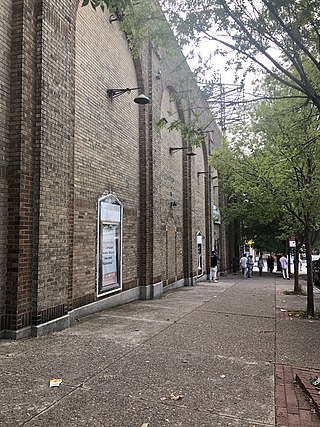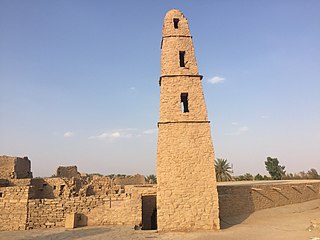Related Research Articles
A mosque, also called a masjid, is a place of worship for Muslims. The term usually refers to a covered building, but can be any place where Islamic prayers are performed, such as an outdoor courtyard.

The Aqsa Mosque, also known as the Qibli Mosque or Qibli Chapel, is the main congregational mosque or prayer hall in the Al-Aqsa mosque compound in the Old City of Jerusalem. In some sources the building is also named al-Masjid al-Aqṣā, but this name primarily applies to the whole compound in which the building sits, which is itself also known as "Al-Aqsa Mosque". The wider compound is known as Al-Aqsa or Al-Aqsa mosque compound, also known as al-Ḥaram al-Sharīf.

A minaret is a type of tower typically built into or adjacent to mosques. Minarets are generally used to project the Muslim call to prayer (adhan) from a muezzin, but they also served as landmarks and symbols of Islam's presence. They can have a variety of forms, from thick, squat towers to soaring, pencil-thin spires.

The Aga Khan Award for Architecture (AKAA) is an architectural prize established by Aga Khan IV in 1977. It aims to identify and reward architectural concepts that successfully address the needs and aspirations of Muslim societies in the fields of contemporary design, social housing, community development and improvement, restoration, reuse and area conservation, as well as landscape design and improvement of the environment.

The Baitul Futuh is a mosque complex of the Ahmadiyya Muslim Community, situated in Morden, London. It is one of the largest mosque complexes in Europe. Completed in 2003 at a cost of £15 million, entirely from donations of Ahmadi Muslims, the Mosque can accommodate a total of 13,000 worshippers. The main mosque has a height of 23m above ground, and to maximise capacity the building extends below ground. Baitul Futuh is located in the south-west London suburb London Borough of Merton. It is situated next to Morden South railway station, 0.4 miles from Morden Underground station and one mile from Morden Road tram stop.

Kobe Mosque, also known as Kobe Muslim Masjid, was founded in October 1935 in Kobe and is Japan's first mosque. It is situated in the Hyōgo Prefecture city of Kobe. Established in October 1935, it holds historical significance as a symbol of the early presence of Islam in Japan. Its construction was funded by donations collected by the Islamic Committee of Kobe from 1928 until its opening in 1935. The mosque was confiscated by the Imperial Japanese Navy in 1943, survived airaids in n 1945, and withstood the Great Hanshin earthquake of 1995. It is located in the Kitano-cho foreign district of Kobe, one of the city's best-known tourist areas which features many old western style buildings.

The Great Mosque of Kufa, or Masjid al-Kufa, is located in Kufa, Iraq and is one of the earliest surviving mosques in the world. The mosque, built in the 7th century, was home to Ali ibn Abi Talib, the 4th Rashidun caliph; and contains the shrine of Muslim ibn Aqeel, his companion Hani ibn Urwa, and the revolutionary, Al-Mukhtar. The mosque has been significantly rebuilt and restored multiple times in its history.

Rasem Jamal Badran is a Saudi Arabian/Jordanian architect of Palestinian descent whose works are based on a methodological approach in defining Architecture as a continuous dialogue between contemporary needs and historical inherited cultural values.

North Manchester Jamia Mosque is a mosque in the Cheetham Hill area of Manchester, run under the headship of Qamaruzzaman Azmi by the Ibadur-Rahman Trust. It is one of the largest Muslim centres in Europe.
The Sheikha Salama Mosque is a mosque in the city of Al Ain, Emirate of Abu Dhabi, the United Arab Emirates. Formerly the largest mosque in use in the city, it is named after Sheikhah Salamah, mother of Sheikh Zayed bin Sultan Al Nahyan, the father of Sheikh Khalifa.
The following lists events that will happen during 2011 in Saudi Arabia.

Phoenix Mosque is a mosque in Hangzhou, Zhejiang, China. It is known for being one of the four great mosques of China. It is also one of the earliest mosque built in China. The origin of this mosque dates back to the Tang or Song dynasty.

The KAFD Grand Mosque is the Juma’ah (Friday) mosque and an architectural centerpiece of the King Abdullah Financial District in Riyadh, Saudi Arabia. The 6,103-square-meter structure sits on a large urban plaza that functions as a public space and, when needed, outdoor prayer area. Inside, the column-free space can accommodate 1,500 prayer spaces over two levels — a large central hall and a mezzanine. Designed by the Riyadh-based architecture and engineering firm Omrania and Associates, the mosque is inspired by the form of the desert rose.

Chinese Islamic architecture, Sino-Islamic architecture, or Islamic architecture of China are terms used to indicate the architectural tradition and cultural heritage of the Muslim populations in China, both of mainland and outer China, which has existed since the 8th century CE to the present. With the acculturation of the Islamic religion within the predominant Han-Chinese culture, a unique architectural style emerged among Chinese Muslims. It became standard for them to incorporate traditional Chinese and Islamic architectural elements together for mosques, prayer halls, mausoleums, and other buildings.

Masjid Al-Jamia is a Sunni mosque in West Philadelphia. It was founded in 1988 by members of the Muslim Students Association at the University of Pennsylvania . Eight years later, the mosque became independent from the Penn MSA and, around 2009, acquired ownership of the building. Located at 4228 Walnut Street, in a historic building formerly occupied by the Commodore Theatre, the mosque currently serves a large and diverse Muslim population in the neighborhood. The mosque's name itself signals its importance to the community, as the Arabic etymology suggests. In Arabic, Masjid Al-Jamia means “the congregational mosque”, typically where Muslims meet for Friday prayers.

The Mosque of Umar ibn al-Khattab is a mosque located within the historic city of Dumat al-Jandal in the Al Jawf Province of Saudi Arabia. The mosque is named after the Rashidun caliph Umar ibn al-Khattab, who is believed to have constructed the mosque, although this claim has been contested. The mosque's minaret is the first of its kind to be built in North Arabia as well.

Education City Mosque, is the national mosque of Education City Al Rayyan in Qatar. It is located in the Minaretein building, which rests on five large columns representing the five pillars of Islam, with each featuring a verse drawn from the Quran. In 2016, the building was nominated by the Royal Institute of British Architects (RIBA) for its inaugural international prize. In 2015, it won the Best Religious Building prize at the World Architecture Festival (WAF) in Singapore. The mosque was designed by the architectural team of Mangera Yvars.

Basuna Mosque, also known as Abu Stait Mosque, is located in the village of Basuna in the Sohag region of Egypt. It was constructed in 2019 by Egyptian architect Waleed Arafa. The mosque was primarily funded by Shaykh Osama al-Azhary, a respected figure in the village, with contributions from the architect as well. The total area of the mosque is 450 m2 (4,800 sq ft). Its architecture, which is based on a modern interpretation of Egyptian tradition, was recognized with the Al-Fozan Mosque Award for excellence in 2021.
References
- ↑ "Abdullatif Al Fozan Award for Mosque Architecture | International Conference on Mosque Architecture" . Retrieved 2022-10-31.
- ↑ Alsammarae, Rima (24 June 2019). "10 mosques shortlisted by Abdullatif Al Fozan Award for Mosque Architecture". middleeastarchitect.com. Retrieved 31 October 2022.
- ↑ Pictures n Ideas (2019-01-28). "AFAMA Third Cycle Short Listed Mosques". Abdullatif Al Fozan Award for Mosque Architecture. Retrieved 2022-10-31.
- ↑ Muslim Voice (2022-01-06). "Seven Mosques Win Abdullatif Al Fozan Architecture Award | The Muslim Voice, Nigeria" . Retrieved 2022-10-31.